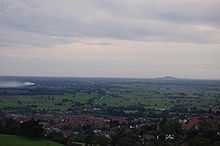Brue Valley Living Landscape

The Brue Valley Living Landscape is a UK conservation project based on the Somerset Levels and Moors in England,and managed by the Somerset Wildlife Trust. The project commenced in January 2009 and aims to restore habitat. It aims to help wildlife sustains itself in the face of climate change[1] while guaranteeing farmers and other landowners can continue to use their land profitably. It is one of an increasing number of landscape scale conservation projects in the UK.[2][3][4]
Location
The project area is approximately 12,500 hectares and covers the floodplain of the River Brue from a little east of Glastonbury to beyond the Catcott, Edington and Chilton Moors SSSI in the west. Almost a quarter of the project area is designated as Site of Special Scientific Interest (SSSI), Special Protection Area (SPA) and Ramsar site. The project area accounts for almost half of the Somerset Levels and Moors SPA.
The area encompasses land already managed for conservation by organisations including Somerset Wildlife Trust, Natural England, the Hawk and Owl Trust and the RSPB. These include Shapwick Heath National Nature Reserve, Westhay Moor, Catcott Lows National Nature Reserve, Ham Wall and Shapwick Moor.
There are 25 scheduled monuments and 746 Historic Environment Records in the project area including internationally important sites such at the Glastonbury Lake Village and Sweet Track. Research on the Somerset Levels and Moors has been crucial to the understanding of the natural and human history of wetlands.[5]
The project is based solely on the peat-based soils of the Somerset Moors. It does not extend on to the marine clay soils of the more westerly Levels.
Project Objectives
The project has five major objectives[6]
- Mapping and research to enable a Local Vision for the Brue Valley,
- Producing a Local Vision that is shared by local government, farmers, the conservation sector and other interest community members,
- Larger and better connected patches of important habitats,
- Working with the local community towards a shared vision for the Brue Valley,
- Developing the management of wildlife habitats in a way which also benefits the local economy and rural society.
Habitats and species targeted
One of the project's goals is to protect, restore and create areas of reedbed, grazing marsh, fen, raised bog, lowland meadow, purple moor grass and rush pastures and wet woodland.
Species of conservation concern (UK BAP priority species) that are likely to benefit from this project include:
Plants
- Divided sedge (Carex divisa)
- English sticky eyebright (Euphrasia anglica)
- Greater water parsnip (Sium latifolium)
- Lesser butterfly orchid (Platanthera bifolia)
- Marsh stitchwort (Stellaria palustris)
- Tubular water dropwort (Oenanthe fistulosa)
Invertebrates
- Argent and sable moth (Rheumaptera hastata)
- Lesser silver water beetle (Hydrochara caraboides)
- Narrow bordered bee hawk-moth (Hemaris tityus)
- One-grooved diving beetle (Bidessus unistriatus)
- Pearl-bordered fritillary (Boloria euphrosyne)
- Shining ram's-horn snail (Segmentina nitida)
- Shrill carder bee (Bombus sylvarum)
- Small heath (Coenonympha pamphilus)
- Small pearl-bordered fritillary (Boloria selene)
Fish
- European eel (Anguilla anguilla)
Reptiles
- European adder (Vipera berus)
- Grass snake (Natrix natrix)
Birds
- Bewick's swan (Cygnus columbianus bewickii)
- Eurasian bittern (Botaurus stellaris)
- Eurasian bullfinch (Pyrrhula pyrrhula)
- Eurasian wigeon (Anas penelope)
- European starling (Sturnus vulgaris)
- Gadwall (Anas strepera)
- Grasshopper warbler (Locustella naevia)
- Hen harrier (Circus cyaneus)
- House sparrow (Passer domesticus)
- Linnet (Carduelis cannabina)
- Marsh harrier (Circus aeruginosus)
- Marsh tit (Poecile palustris)
- Merlin (Falco columbarius)
- Northern lapwing (Vanellus vanellus)
- Peregrine (Falco peregrinus)
- Reed bunting (Emberiza schoeniclus)
- Short-eared owl (Asio flammeus)
- Skylark (Alauda arvensis)
- Song thrush (Turdus philomelos)
- Teal (Anas cracca)
- Willow tit (Poecile montanus)
- Yellowhammer (Emberiza citrinella)
Mammals
- Brown hare (Lepus europaeus)
- Eurasian harvest mouse (Micromys minutus)
- European otter (Lutra lutra)
- Water vole (Arvicola terrestris)
Funding
The project has received funding from the European Regional Development Fund (via the WAVE project),[7] Natural England's Wetland Vision[8] and the Viridor Credits scheme.[9]
See also
References
- ↑ Brue Valley Living Landscape
- ↑ A Living Landscape - The Wildlife Trusts
- ↑ RSPB landscape conservation
- ↑ Natural England Future Landscapes
- ↑ Brunning, Richard (2007). Wet and Wonderful: The Heritage of the Avalon Marshes. Taunton, Somerset: Somerset Heritage Services. ISBN 0-86183-380-5.
- ↑ Wetland Vision Grant Application for Brue Valley Living Landscape Project, May 29, 2009:
- ↑ WAVE
- ↑ Natural England's Wetland Vision
- ↑ Somerset Wildlife Trust press release. Accessed 25/01/10

